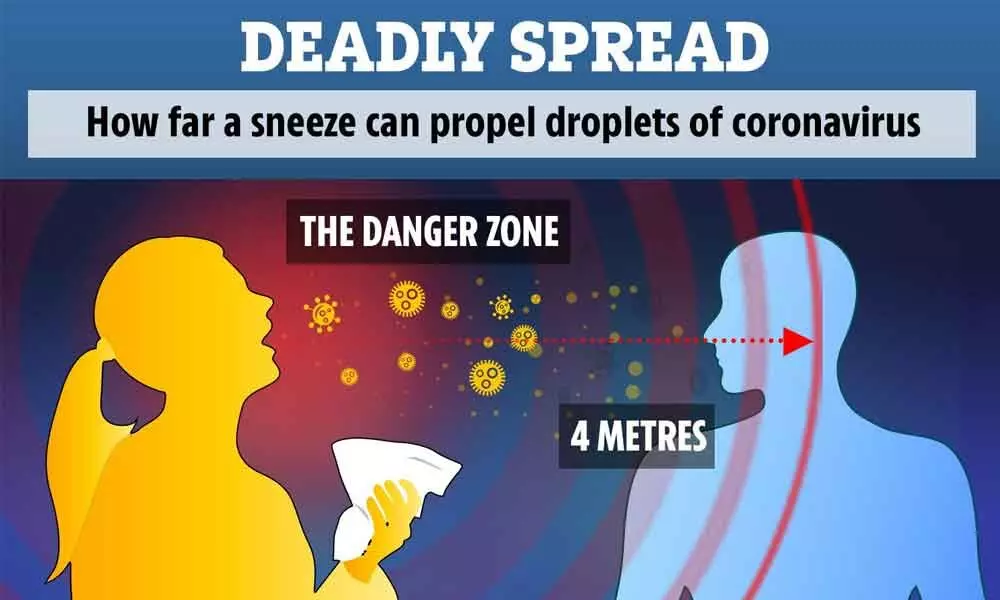Live
- Action icon Sunil Shetty makes a return to Tulu roots with ‘Jai’
- MUDA scam: ED's findings against CM Siddaramaiah escalate political tensions
- Police arrest notorious blackmailer targeting young women
- MLA seeks elevated flyover to ease congestion
- TDP has an ace up its sleeve to breathe fresh air in TG unit
- Vaikuntha Dwara Darshan at Tirumala Temple Comes to a Close
- Civil Servants, Shoulder Shared Responsibilities!
- Hyd-Amaravati bypass bridge works to be completed by April
- Delhi polls: Women voters top agenda of all 3 parties
- Activities launched as part of 12-month action plan
Just In
Coronavirus droplets travels up to 27 feet: MIT scientist


New Delhi: New coronavirus droplets could travel up to 27 feet as a sneeze or a cough results in a turbulent gas cloud that could contain SARS-CoV-2...
New Delhi: New coronavirus droplets could travel up to 27 feet as a sneeze or a cough results in a turbulent gas cloud that could contain SARS-CoV-2 droplets, an MIT researcher has claimed in a paper published in the Journal of the American Medical Association (JAMA).
Lydia Bourouiba, associate professor at MIT and an expert in fluid dynamics, has suggested revising social distancing of six feet (2 metres) to limit the risk of exposure as well as currently used surgical and N95 masks which "are not tested for these potential characteristics of respiratory emissions".
"Mask efficacy as source control depends on the ability of the mask to trap or alter the high-momentum gas cloud emission with its pathogenic payload. Peak exhalation speeds can reach up to 33 to 100 feet per second (10-30 m/s), creating a cloud that can span approximately 23 to 27 feet (7-8 m)," Bourouiba wrote.
In India, the Health Ministry has asked citizens to ensure physical distancing of minimum 1 metre or three feet.
She said that it may seem surprising that the current understanding of the routes of host-to-host transmission in respiratory infectious diseases are predicated on a model of disease transmission developed in the 1930s that, by modern standards, seems overly simplified.
"Recent work has demonstrated that exhalations, sneezes, and coughs not only consist of mucosalivary droplets following short-range semiballistic emission trajectories but, importantly, are primarily made of a multiphase turbulent gas (a puff) cloud that entrains ambient air and traps and carries within it clusters of droplets with a continuum of droplet sizes," Bourouiba emphasized.
The locally moist and warm atmosphere within the turbulent gas cloud allows the contained droplets to evade evaporation for much longer than occurs with isolated droplets.
"Under these conditions, the lifetime of a droplet could be considerably extended by a factor of up to 1000, from a fraction of a second to minutes," said Bourouiba.
Dr Anthony Fauci, the director of the National Institute of Allergy and Infectious Diseases, however urged caution with the MIT study during a White House briefing on Tuesday.
"This could really be terribly misleading," he said, adding that it would apply only to people with extremely strong sneezes.
According to the MIT researcher, "owing to the forward momentum of the cloud, pathogen-bearing droplets are propelled much farther than if they were emitted in isolation without a turbulent puff cloud trapping and carrying them forward".
She explained that that the range of the droplets, both large and small, is extended through their interaction with and trapping within the turbulent gas cloud.
"Droplets that settle along the trajectory can contaminate surfaces, while the rest remain trapped and clustered in the moving cloud," said the researcher.
Eventually the cloud and its droplet payload lose momentum and coherence, and the remaining droplets within the cloud evaporate, producing residues or droplet nuclei that may stay suspended in the air for hours.
"The evaporation of pathogen-laden droplets in complex biological fluids is poorly understood. The degree and rate of evaporation depend strongly on ambient temperature and humidity conditions, but also on the inner dynamics of the turbulent puff cloud coupled with the composition of the liquid exhaled by the patient," she stressed.

© 2025 Hyderabad Media House Limited/The Hans India. All rights reserved. Powered by hocalwire.com






